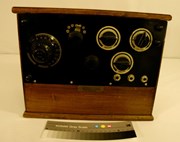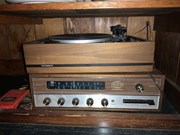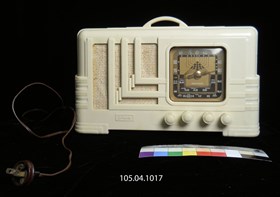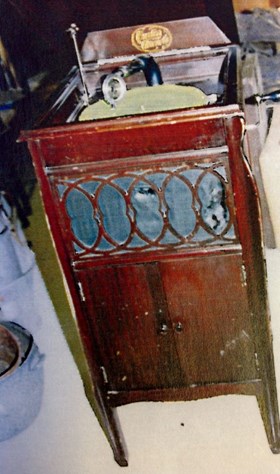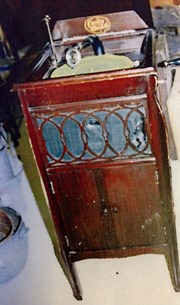Narrow Results By
Peanut Tube Radio
https://archives.whyte.org/en/permalink/artifact105.04.1016%20a-c
- Date
- 1924
- Material
- wood; metal; plastic; glass; fibre
- Catalogue Number
- 105.04.1016 a-c
- Description
- A peanut tube (three-tube) radio enclosed in a varnished brown wooden box/cabinet (a) with a hinged lid. The lid has two small metal screw eyes on each side of the inside (2.0cm from the corner) attaching it to the cabinet which has two metal hooks (2.0cm down from the front corner) screwed into pl…
1 image
- Title
- Peanut Tube Radio
- Date
- 1924
- Material
- wood; metal; plastic; glass; fibre
- Dimensions
- 26 x 18 x 32.5 cm
- Description
- A peanut tube (three-tube) radio enclosed in a varnished brown wooden box/cabinet (a) with a hinged lid. The lid has two small metal screw eyes on each side of the inside (2.0cm from the corner) attaching it to the cabinet which has two metal hooks (2.0cm down from the front corner) screwed into place on both sides. These are used to close the lid securely to the main cabinet. A paper diagram of the circuitry board is tacked to the obverse side of the lid with six metal thumbtacks. The diagram outlines the blueprint of the radio (b), which is separate from the cabinet; the radio slides out of the front from two grooves cut into the sides of the cabinet. The cabinet has two holes bored into the back to attach it to a wall. The front of the radio has a plastic panel secured in place to the base, which is a flat piece of wood, by the dials etc. and four screws on the bottom. Extreme left in the top and bottom corner are two small black plastic knobs; the top knob is the antennae, the bottom is the ground knob. In between these to the middle left is a large plastic knob, black with degrees marked in white, adjustable control (0 increasing by 10’s to a 100 degrees) for station tuning; the small knob in centre (starting at 0 increasing by 5 degrees to 2, then 3, both left and right) is for fine tuning. Next, to the top right is an adjustable black knob with a bent metal contact piece attached; it moves left and right moving to make contact with five metal posts used for switching to different radio bands; two metal posts, one at either end, are used to keep the metal contact piece within the five contact points radius. Below this is a plain black plastic adjustable knob used for sensitivity control for the strength of radio station waves. This goes in and out, further and closer, (it is attached to wires covered with a textile). To the right of these are three black plastic knobs adjustable rheostats (that control the filaments of the three tubes inside (R215-A Vacuum tube); this is the volume control. Three nuts (jack has a thread on it to keep in place) are for jacks for headphone output. Jack 3, closest to the edge of the radio, also controls the switch to the speaker (if you want to have a speaker hooked up to loudspeaker). There are two wires attached different colours; they have a sleeve on the corners so it doesn’t short-circuit.The headphones (c) are hard plastic earpieces (6 cm. in diametre); one has a metal back with “FROST (F)ONES NO. 161 1000” , and three screws underneath the lettering; the other is black hard Bakelite plastic with “National” written in script ,“ELECTRIC” in the tail of the L, underneath that “OHMS 100C SINGLE”, two screws and nuts attaching two-fibre covered wires on either side that connect to the plastic and metal jack plug, “MNFD. BY THE NATIONAL ELECTRIC HEATING COMPANY LIMITED TORONTO CANADA”. Each earpiece has a metal piece attached by rivets to each side allowing it to move. The two-band fibre-covered headpiece is connected to the metal piece by two metal wires. The two fibre-cover wires extending from the earphones are joined and covered with a black cord wound around until it forms a loop which is knotted to close. Two plugs that fit into the jack attachment BARKEKLEW SERIESPAT. PENDING NUMBERS 1,2,3,4, negative on the left side and positive on the right making 8 hole plugs, 2 screws in the place attaching to the metal jack that plugs into the radio.Blueprint hand drawn for back.
- Subject
- households
- furniture
- entertainment
- Credit
- Gift of Lorne Cooley, Banff, 2008
- Catalogue Number
- 105.04.1016 a-c
Images
This material is presented as originally created; it may contain outdated cultural descriptions and
potentially offensive content.
Read more.
- Date
- 1966 – 1968
- Material
- metal; wood; plastic;metal
- Catalogue Number
- 105.03.0020
- Description
- Model 300R Studiotone tuner amplifier receiver, AM/FM stereo. Transistorized, jacks on back for adaptation to different channels and speakers. Six control knobs on front and five selection switches on front. Also headphone jack on front. Removed "Made in Canada" sticker.
1 image
- Title
- Phonograph
- Date
- 1966 – 1968
- Material
- metal; wood; plastic;metal
- Dimensions
- 14.3 x 37.8 x 45.0 cm
- Description
- Model 300R Studiotone tuner amplifier receiver, AM/FM stereo. Transistorized, jacks on back for adaptation to different channels and speakers. Six control knobs on front and five selection switches on front. Also headphone jack on front. Removed "Made in Canada" sticker.
- Credit
- Gift of Catharine Robb Whyte, O. C., Banff, 1979
- Catalogue Number
- 105.03.0020
Images
This material is presented as originally created; it may contain outdated cultural descriptions and
potentially offensive content.
Read more.
Portable; Mantle Radio
https://archives.whyte.org/en/permalink/artifact105.04.1017
- Date
- n.d.
- Material
- plastic, fabric, wood, metal
- Catalogue Number
- 105.04.1017
- Description
- A Lafayette household radio with a cream-coloured plastic shell casing. Generally shaped like a box with rounded corners and edges.The front side has a 4 knobs located in the lower right side. Above these knobs is the radio dial face, which is enclosed in a clear plastic cover. The dial face is met…
1 image
- Title
- Portable; Mantle Radio
- Date
- n.d.
- Material
- plastic, fabric, wood, metal
- Dimensions
- 23.3 x 16.7 x 36.0 cm
- Description
- A Lafayette household radio with a cream-coloured plastic shell casing. Generally shaped like a box with rounded corners and edges.The front side has a 4 knobs located in the lower right side. Above these knobs is the radio dial face, which is enclosed in a clear plastic cover. The dial face is metallic gold and black with white text and a geometric checkerboard graphic . The needle appears to be a bronze coloured metal. There are two rings on the dial face. The outer ring has numbers ranging from 55 to 160 on the top half, and 8.0 to 22 on the bottom half. The inside ring is only numbered on the bottom half and ranges from 2.5 to 6.0 with text at specific increments: POLICE (2.5); AVIATION (3.0); AMATEUR (4.0); AVIATION (5.0); FOREIGN (6.0). To the left of the dial face is the speaker, which is a woven, cream-coloured material set behind bars of plastic that make 90 degree angles.“Lafayette” appears in italic text within a square cartouche left, below the speaker.The back is made of wood and screwed on in the 4 corners. On the back, there are 4 rounded triangle-shaped cutouts, a large central hole, and 5 smaller holes that surround it.The radio stands on 4 black circular feet. A label on the underside reads: Lafayette SUPER HET radio receiver; SERIAL NO. 91367; MODEL NO. JS182There is a small fixed plastic handle 10 cm in length on the top.Electrical cord is black.
- Subject
- households
- furniture
- entertainment
- radio
- Credit
- Gift of Robert Crosby Family, Banff, 1998
- Catalogue Number
- 105.04.1017
Images
This material is presented as originally created; it may contain outdated cultural descriptions and
potentially offensive content.
Read more.
Record Phonograph
https://archives.whyte.org/en/permalink/artifact105.03.1007
- Date
- prior to 1930
- Material
- wood; metal; fibre
- Catalogue Number
- 105.03.1007
- Description
- Tall, footed cabinet style record player. Shaped hinged top, held open with metal hinge. Wooden cut-out circles with fibre lining at voice box. Hinged doors open with five record shelves. Metal crank with black wood handle.
1 image
- Title
- Record Phonograph
- Date
- prior to 1930
- Material
- wood; metal; fibre
- Dimensions
- 114.0 x 46.3 cm
- Description
- Tall, footed cabinet style record player. Shaped hinged top, held open with metal hinge. Wooden cut-out circles with fibre lining at voice box. Hinged doors open with five record shelves. Metal crank with black wood handle.
- Credit
- Gift of Charles C. Reid, Banff, Alberta, 1986
- Catalogue Number
- 105.03.1007
Images
This material is presented as originally created; it may contain outdated cultural descriptions and
potentially offensive content.
Read more.


